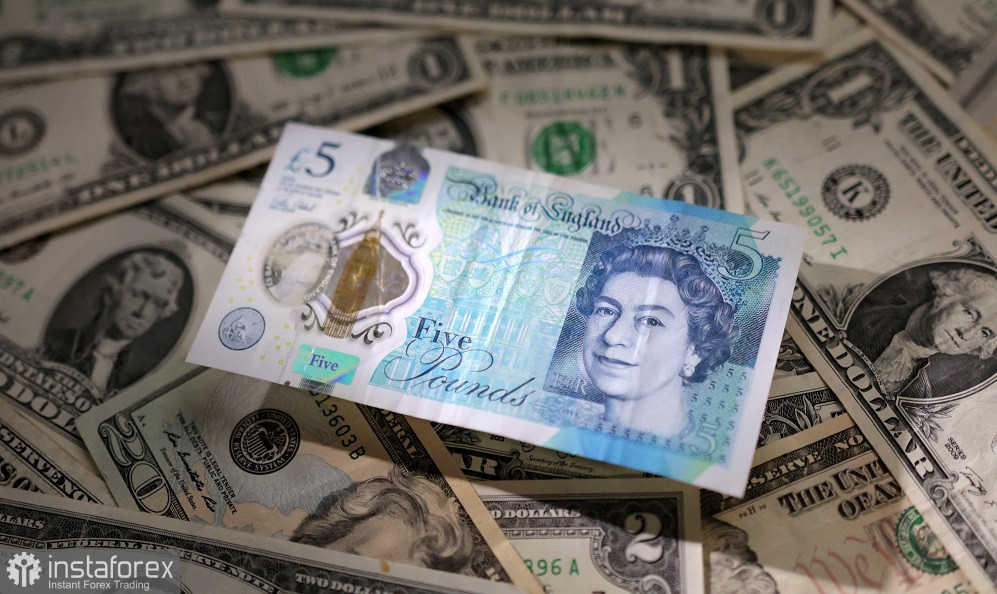When paired with the dollar, the pound remains stagnant, occasionally attempting to decline to the area of the 26th figure. The pair has been trading in the range of 1.2680-1.2800 for the second consecutive week, awaiting the next news drivers.
The wait won't be long – the upcoming days promise to be quite "hot" for GBP/USD traders. Both the greenback and the pound will be in a zone of price turbulence, reacting to their respective fundamental factors. On Thursday in the US, the consumer price index growth report will be published, and on Friday, data on the growth of the British economy for the second quarter (plus the US producer price index) will be released. If these releases resonate in favor or against the dollar, the GBP/USD pair will break out of its sideways movement (the only question is in which direction). Preliminary forecasts suggest that the greenback will benefit from these reports. However, if the US release enters the "red zone," and British figures pleasantly surprise investors with "green figures," GBP/USD buyers will receive far more support than sellers when implementing the "basic" scenario. The plot thickens, so it is currently wise for the pair to maintain a wait-and-see position.

Let's start with the British events. First, it's essential to recall the details of the last Bank of England meeting, after which the Central Bank unexpectedly raised interest rates, contrary to most experts' predictions of maintaining the status quo. The British currency responded quite reservedly to the formally hawkish outcomes of the August meeting. After a brief rise, the GBP/USD pair hit a 5-week price low, dropping to the base of the 26th figure.
The fact is that the head of the Bank of England, commenting on the Central Bank's decision, focused on the side effects of aggressive policy. In particular, Andrew Bailey stated that the Central Bank faced "some unpleasant surprises" in the previous reporting period. Therefore, when deciding the rate, the regulator's members "considered all existing risks."
In July, there were several "unpleasant surprises" for the Bank of England, but among them, the report on the growth of the UK economy stands out. The country's GDP in May unexpectedly shrank by 0.1% (despite a growth forecast of 0.1%), while the previous month had a growth of 0.2%. The volume of industrial production decreased by 0.6% monthly and 2.3% annually. The production volume in the manufacturing sector declined by 1.2% year-on-year, against a forecasted decrease of 1.7%.
On Friday, August 11, we will receive data on the British economy's growth for June and the second quarter. According to preliminary forecasts, the country's GDP for the second quarter will show a zero result (every quarter) and weak growth (0.2%) annually. The June figures are also unlikely to impress GBP/USD buyers (even if they meet forecast levels): the economy in June is projected to grow by 0.1% quarterly and by 0.2% monthly. The volume of industrial production annually is expected to decrease by 1.1% (this would mark the 12th consecutive negative result). The manufacturing sector's production volume is projected to increase by just 0.3% year-on-year.
As we can see, weak forecasts do not bode well for strengthening the British currency. Even if the indicators meet forecast levels (let alone entering the "red zone"), hawkish expectations regarding the English regulator's further actions will weaken. Especially since other macroeconomic indicators also "leave much to be desired." In particular, the latest release in the UK labor market was disappointing. The unemployment rate rose to 4.0% (though most experts were confident that the figure would remain at 3.8%), and unemployment benefits increased by 25,000.
Meanwhile, inflation is showing a downward trend: the overall consumer price index in June on an annual basis was 7.9%, whereas most experts had forecasted a decrease to 8.2%. The core index dropped to the target of 6.9%, while most analysts expected it to remain at the previous month's level, i.e., 7.1%. The retail price index on an annual basis stood at 10.7% in June, with a forecasted decrease to 10.9% (the weakest growth rate since March 2022).
Thus, Friday's release can either strengthen the position of the British currency (if the main indicators exceed analysts' expectations) or "sink" it, intensifying pressure on GBP/USD. The "depth" of the fall or rise of GBP/USD will depend on another report, which will be published a day before the British announcement. As mentioned, the US will release data on the consumer price index growth tomorrow. According to forecasts, the overall CPI is expected to accelerate for the first time in the last 12 months, while the core index, on the other hand, is expected to decelerate. If both indicators show an upward trend, it will be hard for the pound to resist the pressure from GBP/USD sellers - even if the British figures are good.
All of this suggests that the pair will soon enter a zone of price turbulence, following which the price will either drop to the 25-26 figures range or return to the resistance level of 1.2870 (the middle line of the Bollinger Bands indicator, coinciding with the Kijun-sen line on the D1 timeframe).
 English
English 
 Русский
Русский Bahasa Indonesia
Bahasa Indonesia Bahasa Malay
Bahasa Malay ไทย
ไทย Español
Español Deutsch
Deutsch Български
Български Français
Français Tiếng Việt
Tiếng Việt 中文
中文 বাংলা
বাংলা हिन्दी
हिन्दी Čeština
Čeština Українська
Українська Română
Română

